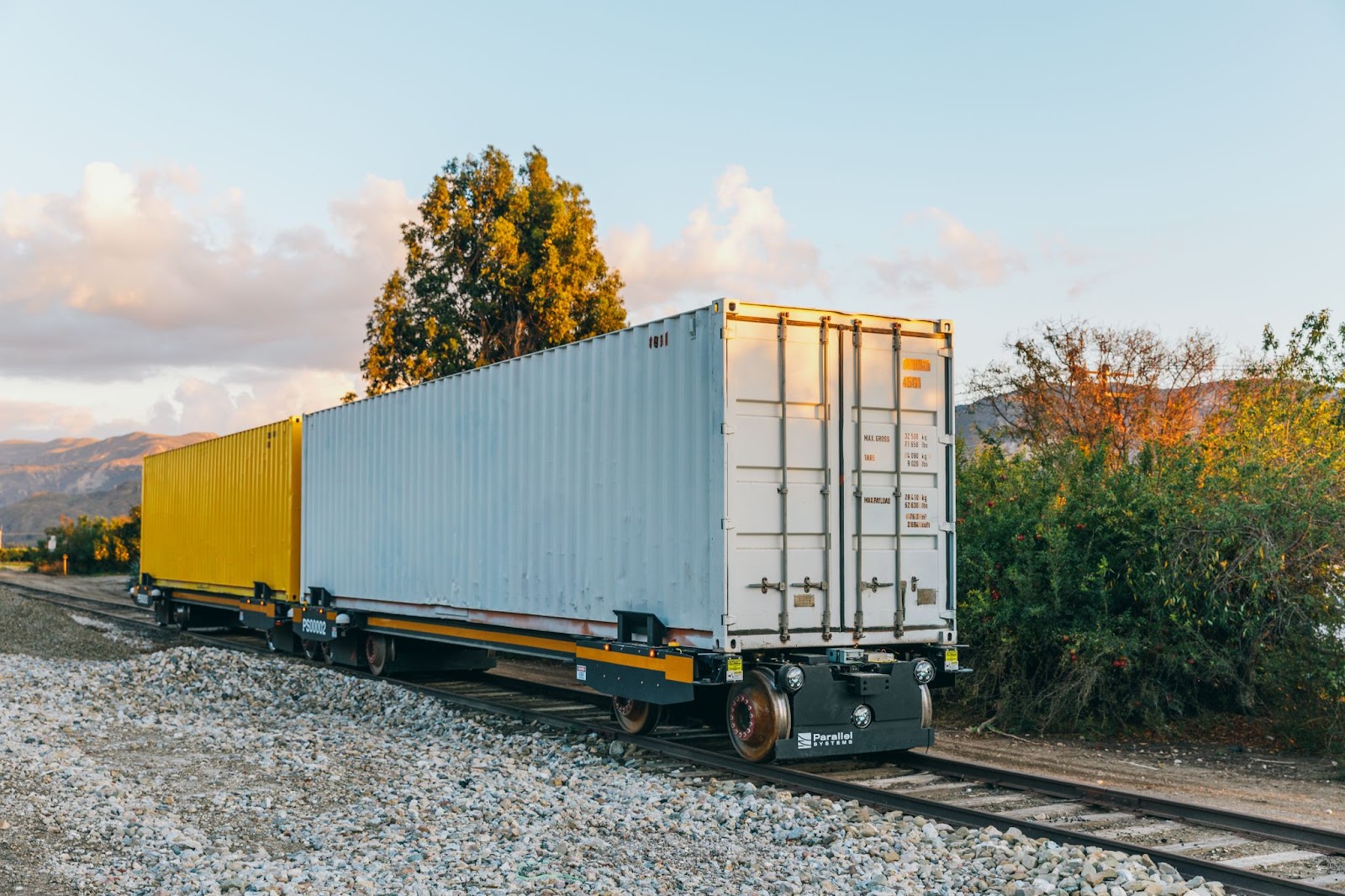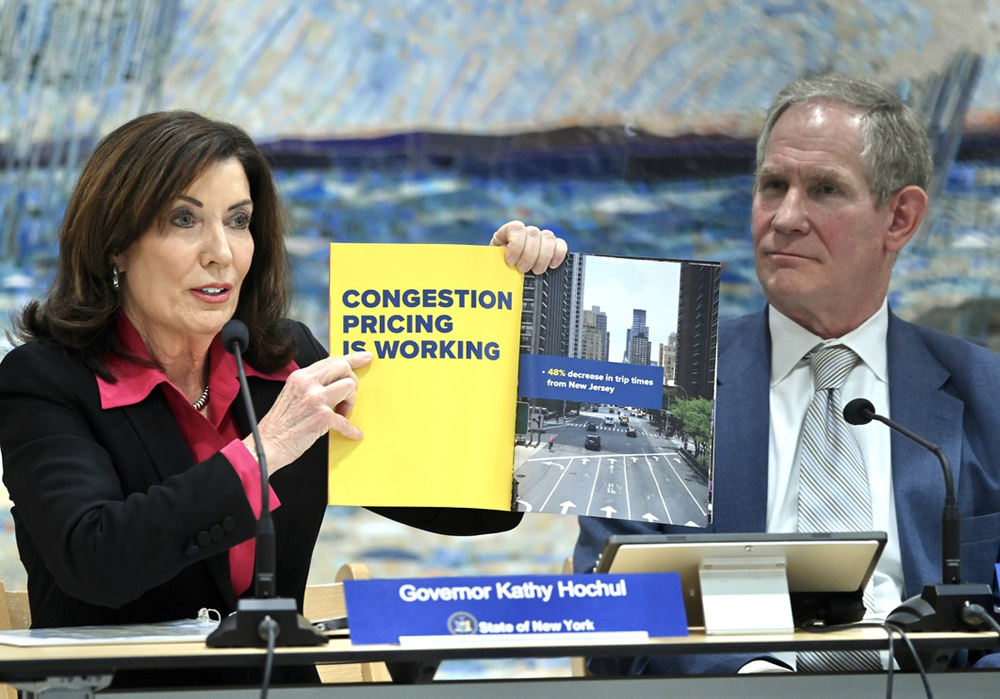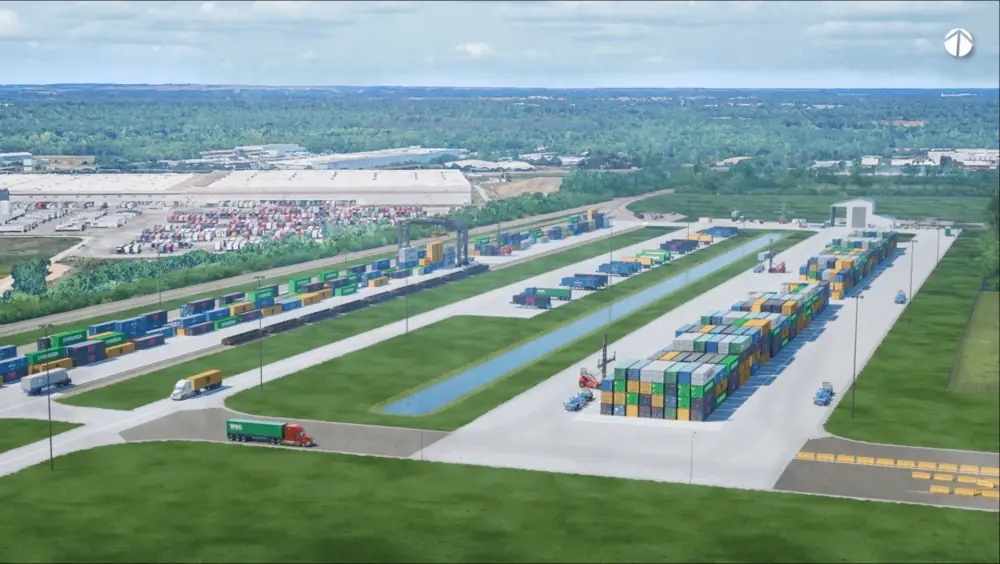
VIDALIA, Ga. – Railroad labor union leaders today urged the Federal Railroad Administration to reject or at least severely restrict a proposal that would allow a pair of Genesee & Wyoming short lines to conduct intensive tests of Parallel Systems autonomous, self-propelled battery-electric freight cars.
The Heart of Georgia and Georgia Central railroads last year asked the FRA to waive a number of federal rail equipment regulations that would allow operation of Parallel’s container cars. The tests aim to prove that the technology is safe and that the equipment can coexist with conventional railroad operations. Parallel says its zero-emissions cars would allow railroads to effectively compete with trucks for short-haul moves.
At a public hearing today, FRA officials heard from Parallel, the G&W short lines, the American Short Line and Regional Railroad Association, elected officials, and area economic development executives. They all touted the potential benefits of shifting freight off the highway to rail and encouraged the FRA to allow the tests to proceed.
Chuck Baker, president of the ASLRRA, noted that short lines can’t win short-haul container business from trucks because the economics don’t pencil out. The autonomous equipment, however, may prove to be effective competition, he says.
If the tests are successful, they could lead to rail service linking ports with inland markets, Baker says. The benefits of a shift of short-haul container traffic to rail include improved safety, reduced wear and tear on taxpayer-supported highways, reduced traffic congestion, and significantly lower emissions, he says.
Brad Lafevers, who founded the Heart of Georgia Railroad and sold it to G&W, tried but ultimately failed to sustain container traffic between the Port of Savannah and an inland terminal at Cordele, Ga., that’s now only served by trucks on Interstate 75.
The Heart of Georgia launched intermodal service between Savannah and Cordele in 2011. But a traffic downturn – when combined with the inflexible economics the five-pack double-stack well car and competition from trucks – forced HOG to shut down the service in 2017. “The market is there. We recognized it was there,” Lafevers says. “There are short haul opportunities.”
But officials from the Brotherhood of Locomotive Engineers and Trainmen, the SMART-TD union that represents conductors, and the Transportation Trades Division of the AFL-CIO all raised red flags about autonomous equipment.
Vince Verna, vice president and national legislative representative for the Brotherhood of Locomotive Engineers and Trainmen, says the union has safety concerns about waiving regulations that have proven their worth.
Parallel’s cars take too long to stop, he says, and their heavy duty batteries would pose firefighting challenges in the event of a derailment. The sensors on the Parallel equipment have nowhere near the ability of a human crew to react to trespassers or rail workers on the right of way, Verna says. And he says it’s unclear how a railroad could effectively respond to a grade crossing accident without personnel on site.
“The technology is just not developed enough yet to meet a basic level of safety…outside of dedicated, unconnected testing facilities,” he says.
He also urged the FRA to avoid repeating what he says was a mistake in approving remote control switching operations. “Before remote control equipment was introduced, no person had ever run themselves over by their own train or cut of cars,” Verna says. “But sadly that’s been a reality too often.”
Jared Cassity, the chief of safety for the SMART-TD union, says Parallel’s equipment poses a derailment risk in bad weather, is vulnerable to cyberattack, and lacks the programming necessary to prevent it from running through misaligned switches.
“There is zero margin for error. Running a switch by even inches on a main line can result in head-on collisions, risking our members’ lives in the oncoming train,” Cassity says. “The expectation for crews is to stop short. The same should be true here.”
The equipment also isn’t ready for operation through grade crossings, he claims, saying demonstrations have shown that the horn sequence doesn’t provide sufficient warning for motorists.
SMART-TD is staunchly opposed to the FRA granting waivers for the pilot program, Cassity says. But if the FRA does decide to approve the waivers, he urged safety officials to require a new waiver for each of the pilot program’s seven phases.
Greg Regan, president of the TTD, agreed. But he went a step further, arguing that FRA should make test data public and allow public comments between each test phase. Waivers of existing safety regulations, he says, should be minimized and considered an extraordinary step.
Railroaders’ voices should be a part of the debate about the deployment of new technology, Regan argues, considering how railroads often look to technology as a way to replace workers.
“This new technology presents workforce challenges and serious safety concerns that the FRA must take into consideration,” Regan says. In evaluating the Parallel test plan, the FRA should consider the long-term safety ramifications of how autonomous equipment would interact with the broader network, he says.
The FRA has received only 19 written comments on the waiver proposal thus far. Most have been in support of the Parallel and G&W request, including from local communities, elected officials, and economic development agencies.
But union officials noted that they have yet to submit their detailed written comments on the proposal.














If a railroad approaches capacity limits with 70 or more trains per day on a 2-main-track environment, think of the capacity issues with many short ‘trains’ composed of Parallel cars.
Trucks are like Parallel cars, except they aren’t autonomous. Capacity for trucks [shared with other vehicles] is provided by a nationwide “4-main-track” environment on the Interstate highway system.
Will the profit contribution of traffic obtained by the use of Parallel cars support any needed infrastructure additions?
How much longer can short lines afford to support union scale? Like the scope clause in the airlines, the pilots unions began to see they wouldn’t be able to get raise/keep their jobs if they kept pushing ALPA scale into planes with less seats, so a two tiered system was agreed on.
I have always wondered why Class 1’s (who abhor daily switching) didn’t work with the unions on a scope clause that tiered union scale based on switching loads vs distance loads. Reduce the cost of switching/last mile delivery. Provide a career path for switching/yard engineers to get promoted into higher paying distance engineering.
If anything, autonomous car delivery “might” help with the California feed deliveries (Foster Farms), or the movement of chlorine into bleach/chem companies who need daily, not 3 a week delivery.
The unions could easily embrace automation by having a new operator job classification created that is trained and qualified to manage those kinds of loads from a console. Make lemonade from the lemons.
I believe some unions are worried about their jobs, instead of looking at the benefits of said equipment. Also, they’re ignoring the entire reason for having a testing environment in the first place.
The argument about remote control locomotives running over crew members should not have been brought up, if that happens it has to be because of human error, not the remote control unit itself(it’s remote control, not autonomous, that means a human has to put it in motion).
These cars will not be zero emissions. How are the components manufactured. NO zero emission factories anywhere. How will they charge the batteries. Electricity? NOT zero emissions. Just because there is no engine does not mean zero emissions. Same thing for zero emissions cars, they don’t exist.
Totally agree with you David. There is no free ride no matter what technology is used. Anything that is created affects the environment in some way, some more than others. Nothing is completely free of pollution.
DAVID — 100% agree. The environmental impact of cars is the number of cars multiplied by the distance driven. EV vs. ICE is a runding error — not necessarily in EV’s favor.